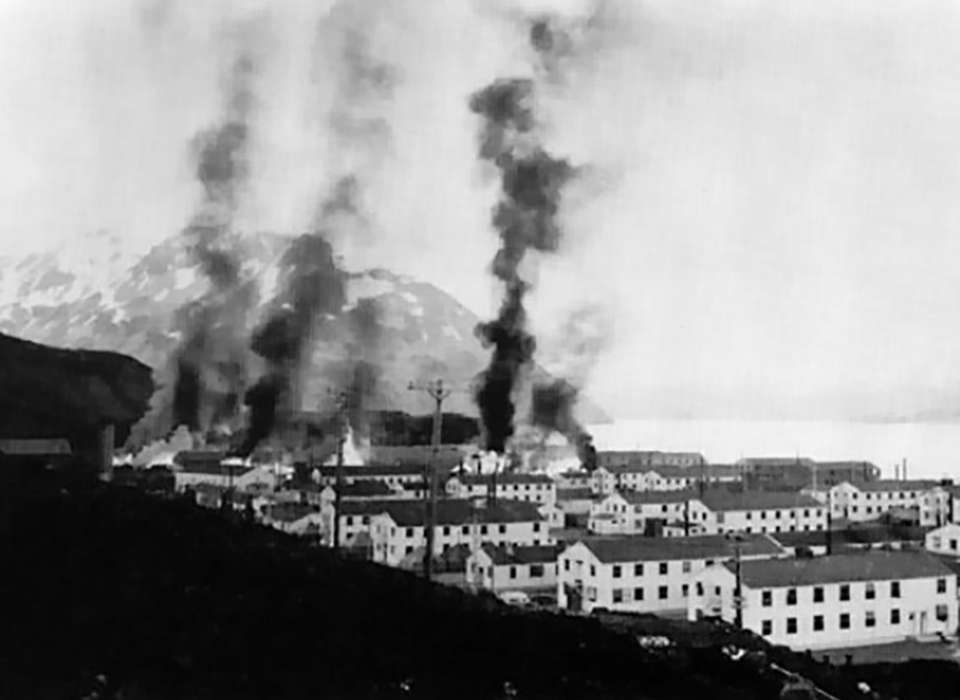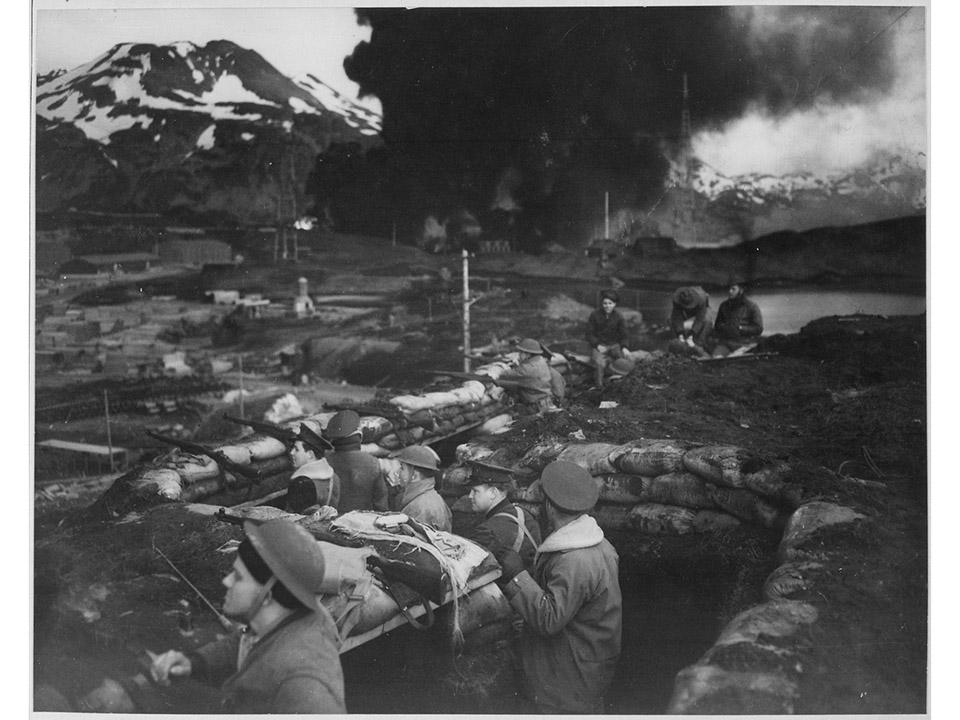Top Image: Barracks buildings at Fort Mears burn following the Japanese attack on June 3, 1942. Courtesy of the National Archives and Records Administration.
In the early morning hours of June 3, 1942, Lt. John Gaines was at his quarters doing his best to keep warm. Even though it was June, the overnight temperatures in Western Alaska and the Eastern Aleutians typically hovered around 40 degrees Fahrenheit Gaines, a battery commander in the 250th Coast Artillery Regiment, was about to crawl into his cot for a few minutes of sleep when he heard the sound of explosions outside. Gaines immediately ran outside and made his way to his battery command post on the ridge overlooking Dutch Harbor. On his way there he could see Japanese planes attacking the naval air station across the harbor. By the time Gaines got to his CP, his gun crews were already at their stations, their 155mm guns pointing out into Iliuliuk Bay past the harbor entrance, ready to engage any enemy warship or surfaced submarine that came within range. As author Brian Garfield termed it, the Thousand Mile War had begun.
Marines manning a trench overlooking Dutch Harbor scan the horizons for any sign of returning Japanese forces in June 1942. Courtesy of the National Archives and Records Administration.
The initial attack on Dutch Harbor on June 3, 1942 was unorganized and caused little damage. Even after the enemy planes left the area Gaines kept his men at their guns. The following day the enemy returned. The Japanese were much better organized on the second day and the bombing attacks on June 4 caused much more damage. The gun pits where Gaines had his howitzers set up were never targeted but he did lose one man who was killed by shrapnel from an enemy bomb during the opening minutes of the attack on June 3. Gaines remained at Dutch Harbor for about six months after the June 3-4, 1942 attacks before returning to the US mainland where he was transferred to an engineer unit. He later took part in the Normandy invasion. Meanwhile, his gun crews kept a constant vigil over the frigid waters of Iliuliuk Bay. On only one occasion did his gunners fire on a surfaced Japanese I-boat, but the enemy vessel was out of range and escaped undamaged.
Two days after the attack on Dutch Harbor, Japanese troops landed on and occupied the Western Aleutian Islands of Kiska and Attu. There was no resistance on either island. On Kiska, a 10 man Navy weather team, and their pet dogs, were captured. One member of the weather team, Aerographer’s Mate 1st Class William C. House, managed to evade capture for fifty days before he was forced to turn himself in or starve to death. When he entered Japanese captivity he weighed about 80 pounds. On the island of Attu, the Japanese “liberated” 43 Unangan, native Aleutian Islanders, and captured C. Foster Jones and his wife Etta. Foster Jones was taken to be questioned by the Japanese and was never seen alive again. He was the only American killed during the Japanese occupation of the Western Aleutians. One Unangan female was wounded. Three months after the Japanese occupation of Attu the “liberated” Unangan and Mrs. Jones were put aboard a cargo ship and sent to Kiska where they spent a day before continuing on to Japan aboard a destroyer. Approximately half of the Aleuts would die during their stay in Japan.
For the first time since the War of 1812, an enemy army occupied American territory. Not only was this a blow to American morale, but by occupying Kiska and Attu, the Japanese now posed a legitimate threat to Alaska and Western Canada. There was no question about it—the Japanese forces perched on America’s back porch were a menace and they simply had to go.
It would be nearly a year before American ground forces finally moved against the Japanese in the Western Aleutians. In May 1943, the US Army’s 7th Infantry Division, supported by Navy and Army Air Force units, arrived off the coast of Attu. The time had come to remove the Japanese threat to the Aleutian Islands.
Joey Balfour
Joey Balfour is the Assistant Director of Oral History at The National WWII Museum and oversees the collection, preservation, of curation of the interviews housed in the Museum’s Oral History Collection.
Cite this article:
MLA Citation:
APA Citation:
Chicago Style Citation:









